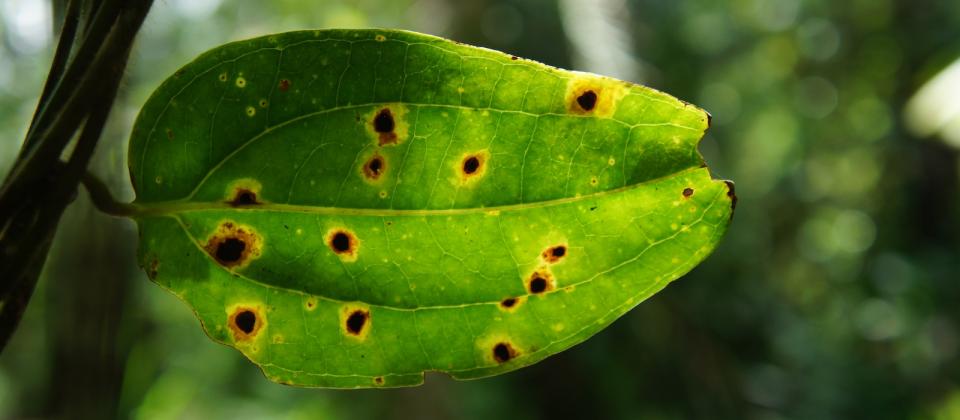Septoria leaf spot is one of the most common diseases affecting cannabis plants. As its very name indicates, it’s a fungal disease starting as numerous tiny spots on the lower leaves of young plants that move up over time. Most commonly found outdoors, leaves begin to show yellowish spots, like rusty-looking crusts that could eventually lead to the death of your plants. We can tell you, though, that this is a rare occurrence. However, it will significantly reduce their yield.

Septoria, also known as "leaf spot disease", is caused by a fungus that attacks cannabis plants and usually appears outdoors with frequent rain and hot climates. Over 1000 species of pathogens can lead to this fungal disease, each infecting a unique and specific host. Of all those, only two infect cannabis and hemp plants: Septoria cannabis and Septoria neocannabina.
The first signs appear on the lowest leaves and move up through the plant during the vegging stage making it unable to carry out most biological processes and, unless properly treated, eventually leading to its death.
Which are those signs?
Plants react to this disease by developing numerous yellow and circular spots on the leaves accompanied by visible discoloration (chlorosis) down the line. Those spots usually have brownish edges and gray pimple-like structures inside. However, it's their round shape that makes them so discernible. Each spot contains fungal spores that look like small dark dots right in the center.
Eventually, those dots dry out and leave like small irregular holes behind. When the infection is too severe, affected leaves start to curl and end up withering completely, leading to the plant's defoliation.
As mentioned before, leaf Septoria affects mostly lower leaves. However, during the flowering, it can also appear on stems and cotyledons.

When does it appear?
This disease usually appears outdoors when the temperature is extremely hot and periods of rain seem to have no end. Septoria leaf spot can also become active when there's a nitrogen deficiency in the substrate, although this is quite rare.
The fungal spores can survive all throughout winter and attack plants during summer, when the moisture and temperature conditions are exactly the ones they need to get back to work. Besides, they spread very quickly via wind, rain, insects, or by physical contact with other plants.

How to fight Septoria leaf spot
- Carefully yet immediately remove all infected leaves in order to get rid of as many spores as possible.
- Prune the bushiest parts to allow for increased aeration.
- Make sure the grow space is properly ventilated and full of fresh, dry, and healthy air. Keep moisture levels low. Air-humidity should never exceed 50%.
- You have to be extra careful when watering your plants, particularly outdoors. Don't let water touch the foliage. Instead of using a sprinkler system, using a drip irrigation or a soaker hose at the base of the plants. Be extremely cautious before dark.
- Keep the substrate and the area surrounding your plants scrupulously clean. Remove all dead leaves and debris for they could still contain spores that may become active when summer-autumn kicks off.
- Spread mulch in your garden to prevent the spores from spreading. Make sure your plants are strong and healthy. Weak plants are more likely to fall victim to Septoria.
- Arrange your plants in such a way that there's enough space between them in order to ensure proper ventilation and to avoid the infested plants to come into contact with the healthy ones.
- Change the location of your plants every year. If this is not possible, then, once you've harvested, remove completely any plant debris and deeply plow the area.
- Use copper-based fungicidal sprays or other full spectrum fungicides to prevent the spreading of this fungus. Best used as a preventive measure. Neem oil might come in handy as well. All you'll need is a hand sprayer to evenly spray all the leaves. Try spraying just one little part of the plant and see how it reacts before spraying it all.
- The incorporation of beneficial microorganisms such as Bacillus Pumilis or Trichoderma can be a great alternative to the use of compost, in case there isn't any. Equally effective is the use of essential oils containing cinnamon, clove, coriander or sesame. Additionally, you can spray the soil surface with compost tea or a sodium bicarbonate solution for they don't let the spores land on it.
- There's no record of one cannabis seed having passed on Septoria cannabis and Septoria neocannabina to another. It'd be wise, however, not to use any seeds from an infected crop.





LEARN SOMETHING NEW EVERYDAY!!! VERY INTERESTING!! I WILL KEEP A LOOK OUT ON MY CANNABIS PLANTS